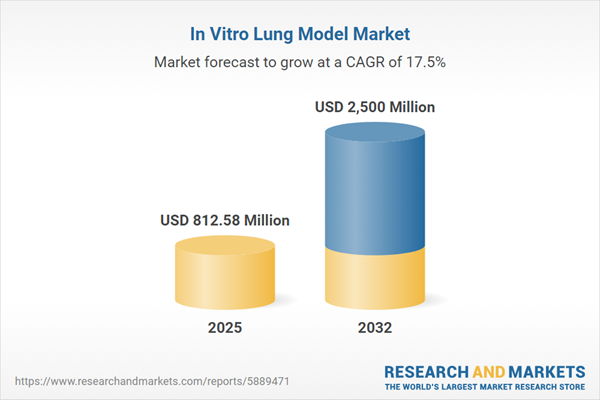Speak directly to the analyst to clarify any post sales queries you may have.
The in vitro lung model market is rapidly becoming an essential resource for executives seeking to modernize respiratory research and sustain regulatory compliance. These sophisticated systems empower organizations to advance innovation, streamline project execution, and respond efficiently to evolving industry expectations.
Market Snapshot: In Vitro Lung Model Market Overview
From 2024 to 2025, the in vitro lung model market expanded from USD 689.38 million to USD 812.58 million, reflecting a robust compound annual growth rate (CAGR) of 17.48%. The sector is forecast to achieve USD 2.50 billion by 2032. Continuous growth is fueled by demand for physiologically relevant simulation tools and an increase in sector investment from both public and private organizations. Expanded adoption within pharmaceutical, biotechnology, and leading research segments has further raised the profile of these platforms, steering industry players toward greater reliability and compliance. As advanced respiratory models become integrated across the life sciences, their influence is shaping collaborative and competitive strategies worldwide.
Scope & Segmentation of the In Vitro Lung Model Market
Precise segmentation allows senior leaders to tailor procurement and resource allocation for strategic impact. The market comprises a wide range of products, technologies, and regional strategies, each significant for navigating sector complexity and maximizing opportunity:
- Model Types: Includes traditional 2D cell cultures, advanced 3D organoids, lung-on-a-chip systems, and precision-cut lung slices, providing flexibility for diverse research and regulatory demands.
- Application Areas: Covers disease modeling, compound screening, drug discovery, personalized medicine, and toxicity assessment, addressing innovation and regulatory needs for research initiatives.
- Cell Sources: Utilizes animal-based platforms, established cell lines, and human-derived primary or stem cells, supporting projects from early-stage investigation to translational research.
- Technologies: Features microfluidic integration, various scaffold-based and scaffold-free designs, and bioreactors, which underpin high-throughput and customizable experimental workflows.
- Product Types: Encompasses research kits, specialized reagents, and lab equipment, all developed to achieve repeatable results and operational efficiency in complex programs.
- End Users: Involves academic labs, contract research organizations, pharmaceutical and biotechnology firms, and public research institutions engaged in validation and program development.
- Geographies Covered: Includes Americas, Europe, Middle East and Africa, and Asia-Pacific, providing opportunities to analyze adoption drivers, competitive landscapes, and regional regulations.
- Company Profiles: Highlights market leaders such as Emulate, MIMETAS, CN Bio Innovations, Hurel Corporation, TissUse, Epithelix, MatTek Life Sciences, InSphero, Kirkstall, and Stemina Biomarker Discovery, each contributing distinctive development strategies.
Key Takeaways for Strategic Decision-Making
- The expanded use of microfluidic platforms and 3D organoid models enables research teams to better replicate human lung physiology, increasing the relevance of experimental results.
- Automation and patient-derived cell systems streamline research workflows, reducing development times and supporting consistent output validation for cross-functional teams.
- Closer partnerships between industry and academic organizations are driving standardization initiatives, making it easier to apply best practices across projects and facilitate technology transfer.
- Regional regulatory differences and changing market dynamics require companies to build adaptable market-entry and development strategies for effective cross-border collaboration.
- The adoption of real-time monitoring and analytics helps organizations enhance risk management and reliability across each stage of drug development and testing.
Tariff Impact and Supply Chain Dynamics
Recent tariff changes in the United States have shifted supply chain strategies for the in vitro lung model market. To mitigate risk and secure operations, many companies are focusing on strengthening domestic production, engaging regional suppliers, and refining logistics systems to adapt to evolving global trade policies.
Methodology & Data Sources
This analysis is built on peer-reviewed studies, detailed industry reports, patent filings, and direct input from procurement and technical leaders. Drawing on these multiple sources ensures insights reflect genuine market trends and inform practical, evidence-based decision-making.
Why This Report Matters
- Equips senior executives to evaluate high-potential partnerships and respond to new opportunities within the in vitro lung model sector.
- Enables agile management of resources and supports the development of effective compliance and procurement initiatives.
- Offers a clear framework for adopting advanced technologies and building robust, future-proof research programs under complex regulatory conditions.
Conclusion
Utilizing targeted segmentation and in-depth regional insight, decision-makers can enhance research performance and maintain regulatory alignment as the in vitro lung model market evolves.
Additional Product Information:
- Purchase of this report includes 1 year online access with quarterly updates.
- This report can be updated on request. Please contact our Customer Experience team using the Ask a Question widget on our website.
Table of Contents
3. Executive Summary
4. Market Overview
7. Cumulative Impact of Artificial Intelligence 2025
Companies Mentioned
The companies profiled in this In Vitro Lung Model market report include:- Emulate, Inc.
- MIMETAS B.V.
- CN Bio Innovations Ltd.
- Hurel Corporation
- TissUse GmbH
- Epithelix Sàrl
- MatTek Life Sciences, Inc.
- InSphero AG
- Kirkstall Ltd
- Stemina Biomarker Discovery, Inc.
Table Information
| Report Attribute | Details |
|---|---|
| No. of Pages | 185 |
| Published | November 2025 |
| Forecast Period | 2025 - 2032 |
| Estimated Market Value ( USD | $ 812.58 Million |
| Forecasted Market Value ( USD | $ 2500 Million |
| Compound Annual Growth Rate | 17.4% |
| Regions Covered | Global |
| No. of Companies Mentioned | 11 |









